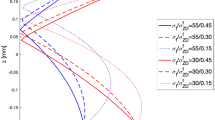Abstract
Tensorial-type failure criteria with linear and quadratic terms are used to calculate the strength of paperboard under plane stress. Theoretical predictions and experimental data are correlated in all four quadrants of biaxial normal stress with various levels of shear. Several methods are examined for determining the interaction coefficientF 12. Comparisons are made with optimum values obtained from least-squares analyses. The best analytical-experimental agreement at all levels of shear is obtained approximately by using coefficientF 12 equal to zero. The sensitivity ofF 12 to errors in experimental input data is also studied. Reliable correlation with experiment, as well as operational simplicity, make these criteria attractive for predicting the strength of paperboard.
Similar content being viewed by others
Abbreviations
- E :
-
elastic modulus
- F ij :
-
strength coefficients
- P :
-
on-axis biaxial tensile strength
- P′ :
-
on-axis biaxial compressive strength
- S :
-
on-axis shear strength
- S 45 :
-
positive shear strength of a 45-deg off-axis coupon
- S′ 45 :
-
negative shear strength of a 45-deg off-axis coupon
- U :
-
uniaxial tensile strength of a 45-deg off-axis coupon
- U′ :
-
uniaxial compressive strength of a 45-deg off-axis coupon
- X :
-
uniaxial tensile strength in the MD
- X′ :
-
uniaxial compressive strength in the MD
- Y :
-
uniaxial tensile strength in the CD
- Y′ :
-
uniaxial compressive strength in the CD
- ν:
-
Poisson's ratio
- σ:
-
normal stress
- τ:
-
shear stress
- x, y, z :
-
coordinate directions
- U θ :
-
uniaxial tensile strength of an off-axis coupon at angle θ
- U′ θ :
-
uniaxial compressive strength of an off-axis coupon at angle θ
- σ c1 , σ c2 :
-
coordinates of the center of the analytical failure envelopes
- S c :
-
maximum unfailed level of shear stress
- MD:
-
machine direction
- CD:
-
cross-machine direction
References
Rowlands, R.E., “Strength (Failure) Theories and Their Experimental Correlation,” Handbook of Composite Materials,III,ed. G.C. Sih and A.M. Skudra, Elsevier Scientific Publishers (1985).
de Ruvo, A., Carlsson, L. andFellers, C., “The Biaxial Strength of Paper, TAPPI,63 (5),133–136 (1980).
Fellers, C., Westerbind, B. and de Ruvo, A., “An Investigation of the Biaxial Failure Envelope of Paper,” to appear in Proc. 1981 Cambridge Symp. (in press).
Gunderson, D.E. and Rowlands, R.E., “Determining Paperboard Strength—Biaxial Tension, Compression, and Shear,” Proc. Int. Paper Physics Conf., TAPPI Press, 253–263 (1983).
Rowlands, R.E., Gunderson, D.E., Suhling, J.C. and Johnson, M.W., “Biaxial Strength of Paperboard Predicted by Hill-Type Theories,” to appear in J. Strain Anat.
Tennyson, R.C., MacDonald, D. andNanyaro, A.P., “Evaluation of the Tensor Polynomial Failure Criterion for Composite Materials,”J. Comp. Mat.,12 (1),63–75 (1978).
Tennyson, R.C., Nanyaro, A.P. andWharram, G.E., “Application of the Cubic Polynomial Strength Criterion to the Failure Analysis of Composite Materials,”J. Comp. Mat. Supplement,14,28–41 (1980).
Malmeister, A.K., “Geometry of Theories of Strength,”Mekhanika Polimerov,2 (4),519–534 (1966).[English translation: Polymer Mechanics,2 (4), 324–331, Faraday Press.]
Tsai, S.W. andWu, E.M., “A General Theory of Strength for Anisotropic Materials,”J. Comp. Mat.,5 (1),58–80 (1971).
Gol'denblat, I.I. andKopnov, V.A., “Strength of Glass-Reinforced Plastics in the Complex Stress State,”Mekhanika Polimerov,1 (2),70–78 (1965).[English translation; Polymer, Mechanics 1 (2), 54–59, Faraday Press.]
Pipes, R.B. andCole, B.W., “On the Off-Axis Strength Test for Anisotropic Materials,”J. Comp. Mat.,7 (2),246–256 (1973).
Hoffman, O., “The Brittle Strength of Orthotropic Materials,”Ibid.,1 (2),200–206 (1967).
Cowin, S.C., “On the Strength Anisotropy of Bone and Wood,”J. Appl. Mech.,46 (4),832–838 (1979).
Wu, E.M., “Optimal Experimental Measurements of Anisotropic Failure Tensors,”J. Comp. Mat.,6 (4),472–489 (1972).
Gunderson, D.E., “Edgewise Compression Testing of Paperboard—A New Concept of Lateral Support,”APPITA,37 (2),137–141 (1983).
Hankinson, R.L., “Investigation of Crushing Strength of Spruce at Varying Angles of Grain,”U.S. Air Service Information Circular,3 (259), (1921).
Suhling, J.C., “Failure Predictions for Paper under Plane Stress,”Internal Rep., Mech. Dept., Univ. of Wisconsin, Madison (1982).
Narayanaswami, R. andAdelman, H.M., “Evaluation of the Tensor Polynomial and Hoffman Strength Theories for Composite Materials,”J. Comp. Mat.,11 (4),366–377 (1977).
Author information
Authors and Affiliations
Rights and permissions
About this article
Cite this article
Suhling, J.C., Rowlands, R.E., Johnson, M.W. et al. Tensorial strength analysis of paperboard. Experimental Mechanics 25, 75–84 (1985). https://doi.org/10.1007/BF02329129
Revised:
Issue Date:
DOI: https://doi.org/10.1007/BF02329129




